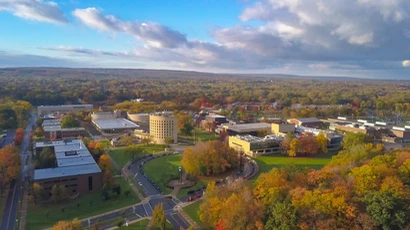
Asbestos Abatement
All asbestos abatement work performed on campus is completed following the guidelines set forth by regulations 29 CFR 1910.1001, and title 12 of NYCRR Part 56, commonly referred to as Code Rule 56. Code Rule 56 requires licensing of contractors, certification of all persons working on asbestos projects, filing of notifications of large asbestos projects and pre-demolition surveys of buildings to identify any asbestos which may be present to ensure proper abatement of asbestos materials. The Environmental Protection Agency (EPA) and national databases established under the federal National Emission Standards for Hazardous Air Pollutants (NESHAP) and NARS/ACTS also oversee asbestos operations.
Asbestos exists in many materials on the campus and around the world. Asbestos is a strong, durable material able to withstand extreme temperatures and abuse. Some of the common materials that contain asbestos include floor and ceiling tile, wall and ceiling plaster, caulking, window glazing, flooring mastic, roof materials, siding, boiler linings and pipe insulation. There are three categories of asbestos: surfacing materials, thermal system insulation (TSI) and miscellaneous building materials.
When left intact and undisturbed, these materials do not pose a health risk to building occupants. There is a potential for exposure only when the material becomes damaged to the extent that asbestos fibers become airborne and are inhaled. Asbestos is more likely to release fibers when it is friable. The term friable means the material can be easily crumbled. If powdered or friable forms of asbestos are disturbed and become airborne, an inhalation hazard may result. In non-friable materials like floor tile, ceiling tiles, laboratory cabinet tops, and caulks, the asbestos fibers are tightly bound in a matrix which prevents the release of fibers to the environment unless the material is abraded, sanded or sawed. It is not necessary to remove all asbestos containing materials from a building to assure a safe workplace. The identification and monitoring of existing asbestos containing materials (ACM) in buildings and proper management of the materials drastically reduces the potential for exposure.
Damaged asbestos containing materials (ACM) or materials presumed to contain asbestos (PACM) should be reported to the Director of Facilities Services immediately. The damaged material or suspect material will be inspected to determine the appropriate remedy such as removal, repairing or encapsulating the material. Do not attempt to handle the material.
If exposed to asbestos, several factors may influence whether harmful health effects will occur. These factors include the dose (how much), the duration (how long), and whether or not you smoke. Generally, adverse health effects from asbestos are the result of long-term exposure to high concentration of airborne fibers. According to the EPA, airborne asbestos levels in buildings are typically very much lower than those identified in industrial work places where asbestos health effects have been observed. People, who have been exposed to asbestos and are also exposed to cigarette smoke, have a greater risk of developing lung cancer than someone who does not smoke.
Helpful links:
- NYS Industrial Code Rule #56
- New York State Department of Labor Division of Health and Safety (NYSDOL)
- NYS Department of Health Asbestos Information
- Asbestos.com
- Construction and Mesothelioma
- Asbestos and Home Owners Guide
- LawFirm.com
- Pleural Mesothelioma Center
- Mesothelioma.com
- Mesothelioma Fund
- Mesothelioma Guide
- Mesothelioma Help
- Mesothelioma Lawyer Center
- Mesothelioma.net
- Mesothelioma Group
- Fredonia Office of Environmental Health & Safety & Sustainability
- MesotheliomaVeterans.org
- Mesothelioma Hub
- Mesothelioma + Asbestos Awareness Center
- Simmons Hanly Conroy - Helping those with Mesothelioma
- BCBH Law Useful Asbestos Information link: http://bcbhlaw.com/
